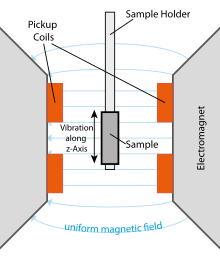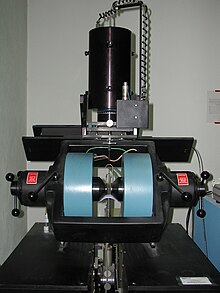

A vibrating-sample magnetometer (VSM) (also referred to as a Foner magnetometer) is a scientific instrument that measures magnetic properties based on Faraday’s Law of Induction. Simon Foner at MIT Lincoln Laboratory invented VSM in 1955 and reported it in 1959. Also it was mentioned by G.W. Van Oosterhout and by P.J Flanders in 1956. A sample is first placed in a constant magnetic field and if the sample is magnetic it will align its magnetization with the external field. The magnetic dipole moment of the sample creates a magnetic field that changes as a function of time as the sample is moved up and down. This is typically done through the use of a piezoelectric material. The alternating magnetic field induces an electric field in the pickup coils of the VSM. The current is proportional to the magnetization of the sample - the greater the induced current, the greater the magnetization. As a result, typically a hysteresis curve will be recorded and from there the magnetic properties of the sample can be deduced.
The idea of vibrating sample came from D. O. Smith's vibrating-coil magnetometer.
Typical VSM overview
Parts of a typical VSM setup

- Actively cooled electromagnet/power supply
- Amplifier
- Control Chassis
- Meter
- Computer interface
- Sensor coils
- Vibration exciter with sample holder
- Hall probe (optional)
Sample Operating Procedure:
- Mounting the sample in the sample holder
- Turning on the VSM system
- Run the computer software to initialize the system
- Calibrate the system
- Optimize the system for M
- Calibrate the Lock-In Amplifier
- Take measurements and record data
Conditions for VSM to be effective
- Magnetic field must be strong enough to fully saturate the samples (or else inaccurate measurements will be taken)
- Magnetic field must be uniform across the sample space (otherwise the addition of field gradients will induce force that alter the vibration once again leading to inaccurate results
Importance of pick-up coils
These allow the VSM to maximize the induced signal, reduce the noise, give a wide saddle point, minimize the volume in between the sample and electromagnet to achieve a more uniform magnetic field at the sample space. The configuration of the coils can vary depending on the type of material being studied.
Relation to Physics
The VSM relies on Faraday's law of induction, with the detection of the emf given by , where N is the number of wire turns, A is the area, and the angle between the normal of the coil and the B field. However, N and A are often unnecessary if the VSM is properly calibrated. By varying the strength of the electromagnet through computer software, the external field is sweeped from high to low and back to high. Typically this is automated through a computer process and a cycle of data is printed out. The electromagnet is typically attached to a rotating base so as to allow the measurements be taken as a function of angle. The external field is applied parallel to the sample length and the aforementioned cycle prints out a hysteresis loop. Then using known magnetization of the calibration material and wire volume the high field voltage signal can be converted into emu units - useful for analysis.
Advantages and Disadvantages
The precision and accuracy of VSM's are quite high even among other magnetometers and can be on the order of ~ emu. VSM's further allow for a sample to be tested at varying angles with respect to its magnetization letting researchers minimize the effects of external influences. However, VSM's are not well suited for determining the magnetization loop due to the demagnetizing effects incurred by the sample. VSM's further suffer from temperature dependence and cannot be used on fragile samples that cannot undergo acceleration (from the vibration).
References
- Foner, Simon (1959). "Versatile and Sensitive Vibrating-Sample Magnetometer". Rev. Sci. Instrum. 30 (7): 548–557. Bibcode:1959RScI...30..548F. doi:10.1063/1.1716679.
- Van Oosterhout, G.W. (1956). Appl. Sci. Res. B6: 101.
{{cite journal}}: Missing or empty|title=(help) - Flanders, P.J. (1956). IEEE Special Publication, Conference on Magnetism and Magnetic Materials. T-91: 315–317.
{{cite journal}}: Missing or empty|title=(help) - ^ SWT Physics Department. "Vibrating Sample Magnetometer" (PDF).
- ^ Lopez-Dominguez, V.; Quesada, A.; Guzmán-Mínguez, J. C.; Moreno, L.; Lere, M.; Spottorno, J.; Giacomone, F.; Fernández, J. F.; Hernando, A.; García, M. A. (2018-03-01). "A simple vibrating sample magnetometer for macroscopic samples". Review of Scientific Instruments. 89 (3): 034707. Bibcode:2018RScI...89c4707L. doi:10.1063/1.5017708. hdl:10261/163494. ISSN 0034-6748. PMID 29604780.
- Smith, D. O. (1956). "Development of a Vibrating‐Coil Magnetometer". Rev. Sci. Instrum. 27 (261): 261–268. Bibcode:1956RScI...27..261S. doi:10.1063/1.1715538.
- ^ Burgei, Wesley; Pechan, Michael J.; Jaeger, Herbert (2003-07-10). "A simple vibrating sample magnetometer for use in a materials physics course". American Journal of Physics. 71 (8): 825–828. Bibcode:2003AmJPh..71..825B. doi:10.1119/1.1572149. ISSN 0002-9505.
- ^ "Interpretation of Vibrating Sample Magnetometer (VSM) analysis". analyzetest.com. 2021-03-16. Retrieved 2021-05-14.
 , where N is the number of wire turns, A is the area, and
, where N is the number of wire turns, A is the area, and  the angle between the normal of the coil and the B field. However, N and A are often unnecessary if the VSM is properly calibrated. By varying the strength of the electromagnet through computer software, the external field is sweeped from high to low and back to high. Typically this is automated through a computer process and a cycle of data is printed out. The electromagnet is typically attached to a rotating base so as to allow the measurements be taken as a function of angle. The external field is applied parallel to the sample length and the aforementioned cycle prints out a
the angle between the normal of the coil and the B field. However, N and A are often unnecessary if the VSM is properly calibrated. By varying the strength of the electromagnet through computer software, the external field is sweeped from high to low and back to high. Typically this is automated through a computer process and a cycle of data is printed out. The electromagnet is typically attached to a rotating base so as to allow the measurements be taken as a function of angle. The external field is applied parallel to the sample length and the aforementioned cycle prints out a  emu. VSM's further allow for a sample to be tested at varying angles with respect to its magnetization letting researchers minimize the effects of external influences. However, VSM's are not well suited for determining the magnetization loop due to the demagnetizing effects incurred by the sample. VSM's further suffer from temperature dependence and cannot be used on fragile samples that cannot undergo acceleration (from the vibration).
emu. VSM's further allow for a sample to be tested at varying angles with respect to its magnetization letting researchers minimize the effects of external influences. However, VSM's are not well suited for determining the magnetization loop due to the demagnetizing effects incurred by the sample. VSM's further suffer from temperature dependence and cannot be used on fragile samples that cannot undergo acceleration (from the vibration).